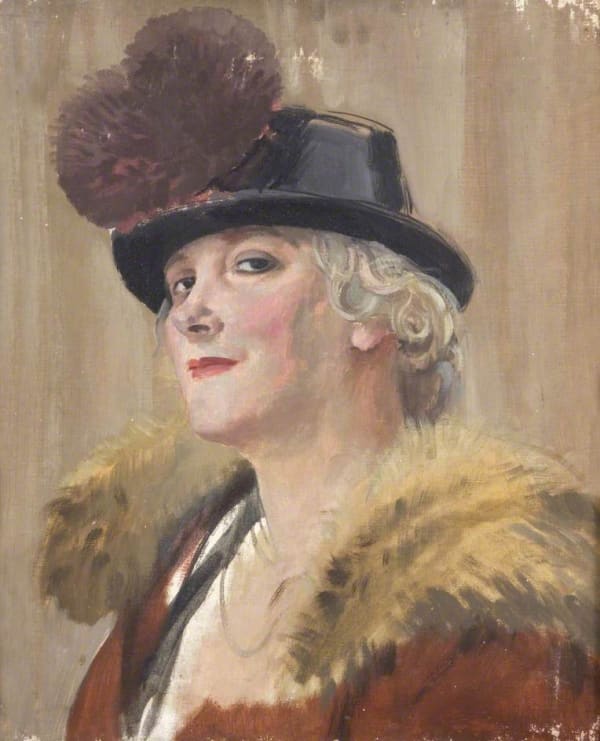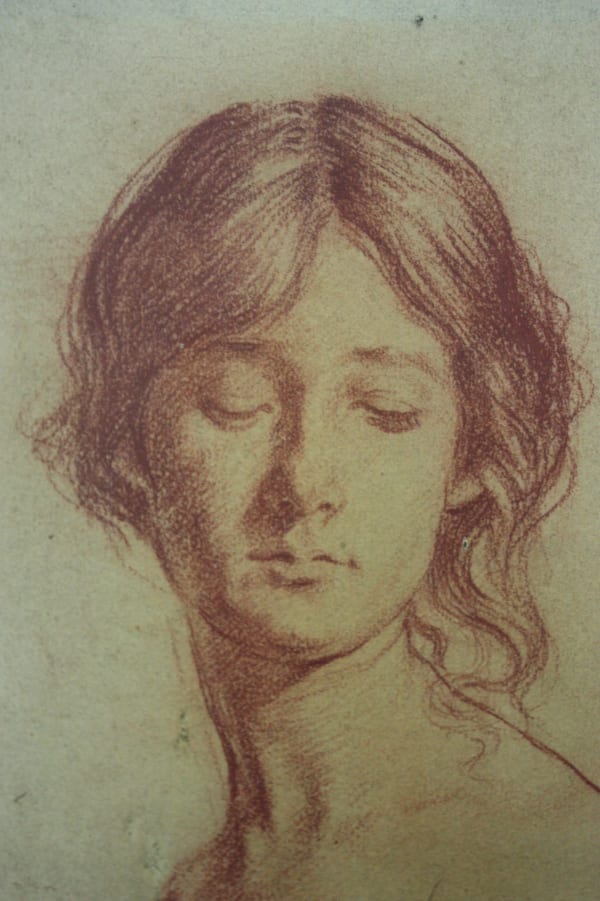Augustus Edwin John OM RA NEAC (4 January 1878–31 October 1961) was a Welsh painter, draughtsman, and etcher. He was elected to the New English Art Club in 1903.
For a time, he was considered the most important artist at work in Britain. Virginia Woolf remarked that by 1908, the era of John Singer Sargent and Charles Wellington Furse "was over. The age of Augustus John was dawning." He was the younger brother of the painter Gwen John.
Early Life
Born in Tenby, Pembrokeshire, John was the younger son and third of four children. His father was Edwin William John, a Welsh solicitor; his mother, Augusta Smith died young when he was six, but not before inculcating a love of drawing in both Augustus and his older sister Gwen.
At the age of seventeen, he briefly attended the Tenby School of Art, then left Wales for London, studying at the Slade School of Art, University College London. He became the star pupil of drawing teacher Henry Tonks and even before his graduation he was considered the most talented draughtsman of his generation. His sister, Gwen was with him at the Slade and became an important artist in her own right.
In 1897, John hit submerged rocks diving into the sea at Tenby, suffering a serious head injury. The lengthy convalescence that followed seems to have stimulated his adventurous spirit and accelerated his artistic growth. In 1898, he won the Slade Prize with Moses and the Brazen Serpent. John afterwards studied independently in Paris where he seems to have been influenced by Pierre Puvis de Chavannes.
The need to support Ida Nettleship (1877–1907), whom he married in 1901, led him to accept a post teaching art at the University of Liverpool.
North Wales
Over a period of two years, from around 1910, Augustus John and his friend James Dickson Innes painted in the Arenig valley, in particular the mountain Arenig Fawr. In 2011, this period was made the subject of a BBC documentary titled The Mountain That Had to Be Painted.
Provence, France
In February 1910, John visited and fell in love with the town of Martigues in Provence. John wrote that Provence "had been for years the goal of my dreams" and Martigues was the town for which he felt the greatest affection. "With a feeling that I was going to find what I was seeking, an anchorage at last, I returned from Marseilles, and, changing at Pas des Lanciers, took the little railway which leads to Martigues. On arriving my premonition proved correct: there was no need to seek further." The connection with Provence continued until 1928, by which time John felt the town had lost its simple charm, and he sold his home there.
John was, throughout his life, particularly interested in the Romani people and sought them out on his frequent travels around the United Kingdom and Europe, learning to speak various versions of their language. For a time, shortly after his marriage, he and his family (which included his wife Ida, mistress Dorothy (Dorelia) McNeill, and John's children by both women) travelled in a caravan. Later on, he became the President of the Gypsy Lore Society.
The First World War
In December 1917, John was attached to the Canadian forces as a war artist and made a number of memorable portraits of Canadian infantrymen. The end result was to have been a huge mural for Lord Beaverbrook and the sketches and cartoon for this suggest that it might have become his greatest large-scale work. However, like so many of his monumental conceptions, it was never completed.
As a war artist, John was allowed to keep his beard and he and King George V were the only army officers in the Allied forces to have beards, apart from pioneer sergeants and those who were allowed unshaven for medical reasons. After two months in France, he was sent home in disgrace after taking part in a brawl. Lord Beaverbrook, whose intervention saved John from a court-martial, sent him back to France where he produced studies for a proposed Canadian War Memorial picture, although the only major work to result from the experience was Fraternity. In 2011, the Duke and Duchess of Cambridge finally unveiled this mural at the Canadian War Museum in Ottawa.
Portraits
Although known early in the century for his drawings and etchings, the bulk of John's later work consisted of portraits. Those of his two wives and his children were regarded as among his best. He was known for the psychological insight of his portraits, many of which were considered ‘cruel’ for the truth of the depiction. Lord Leverhulme was so upset with his portrait that he cut out the head (since only that part of the image could easily be hidden in his vault) but when the remainder of the picture was returned by error to John there was an international outcry over the desecration.
By the 1920s, John was Britain's leading portrait painter. John painted many distinguished contemporaries, including T. E. Lawrence, Thomas Hardy, W. B. Yeats, Aleister Crowley, Lady Gregory, Tallulah Bankhead, George Bernard Shaw, the cellist Guilhermina Suggia, the Marchesa Casati and Elizabeth Bibesco. Perhaps his most famous portrait is of his fellow countryman, Dylan Thomas, whom he introduced to Caitlin Macnamara, his sometime lover who later became Thomas's wife. Portraits of Dylan Thomas by John are held by the National Museum Wales and the National Portrait Gallery.
It was said that after the war, his powers diminished as his bravura technique became sketchier. One critic has claimed that "the painterly brilliance of his early work degenerated into flashiness and bombast, and the second half of his long career added little to his achievement." However, from time to time his inspiration returned, as it did on a trip to Jamaica in 1937. The works done in Jamaica between March and May 1937 evidence a resurgence of his powers and amounted to "the St. Martin's summer of his creative genius". In 1944, Sir Bernard Montgomery commissioned a portrait of himself, but rejected the completed work "because it was not like me". It was subsequently purchased by the Hunterian Art Gallery in Glasgow.
Later Life and Death
He joined the Peace Pledge Union as a pacifist in the 1950s and was a founder member of the Committee of 100. On 17 September 1961, just over a month before his death, he joined the committee's anti-nuclear weapons demonstration in Trafalgar Square, London. At the time, his son, Admiral Sir Caspar John was First Sea Lord and Chief of Naval Staff. He died at Fordingbridge, aged 83.
Collections
His work is held in the permanent collections of many museums worldwide, including the Museum of New Zealand, the Santa Barbara Museum of Art, the British Museum, the Museum of Modern Art the University of Michigan Museum of Art, the Brooklyn Museum, the National Museum Wales, the Detroit Institute of Arts, and the Philadelphia Museum of Art.
This is an edited version of Augustus John's Wikipedia biography.
You can also view over 300 of his artworks on his ArtUK website page.


